Text
Yessssssss! I wrote a whole fucking essay about "realistic medieval warhorses!"
My post focuses more on "DRAFT HORSES ARE NOT WARHORSES!!! SHIRES AND CLYDESDALES ARE BASICALLY-MODERN CINNAMON ROLLS WITH WITH ALL THE ATHLETICISM OF A PICKUP TRUCK!!! REAL-LIFE WARHORSES WERE THE MEDIEVAL EQUIVALENT OF SPORTS CARS!!!", but I did make a BIG note about Friesians being overused in modern-day medieval movies just because they've got nice hair.
Judging by the stuff I've heard about actual riders doing a test drive for Friesians, any knight who tried riding a Friesian into battle would be bounced off their own horse like a tennis ball at any speed past a walk. Not a good omen when battle tends to be a LOT faster than a trail ride.
My Biggest and Most Annoying Fictional Horse Pet Peeve
Big Horses are a Very New Thing and they Likely Didn’t Exist in your Historical and/or Fantasy Settings.
You’ve all seen it in every historical piece of media ever produced. Contrary to popular belief, a big black horse with long legs and long flowing mane is not a widespread or even a particularly old type of horse.

THIS IS NOT A MEDIEVAL THING. THIS IS NOT EVEN A BAROQUE THING. THIS IS A NINETEENTH CENTURY CITY CARRIAGE HORSE.
All the love to fancy Friesian horses, but your Roman general or Medieval country heroine just really couldn’t, wouldn’t, and for the sake of my mental health shouldn’t have ridden one either.
Big warmblood horses are a Western European and British invention that started popping up somewhere around 1700s when agriculture and warfare changed, and when rich folks wanted Bigger Faster Stronger Thinner race horses.
The modern warmblood and the big continental draught both had their first real rise to fame in the 1800s when people started driving Fancy Carriages everywhere, and having the Fanciest Carriage started to mean having the Tallest and Thinnest Horses in the town.
Before mechanised weaponry and heavy artillery all horses used to be small and hardy easy-feeders. Kinda like a donkey but easier to steer and with a back that’s not as nasty and straight to sit on.
SOME REAL MEDIEVAL, ROMAN, OTTOMAN, MONGOL, VIKING, GREEK and WHATEVER HISTORICALLY PLAUSIBLE HORSES FOR YOU:
“Primitive”, native breeds all over the globe tend to be only roughly 120-140 cm (12.0 - 13.3 hh) tall at the withers. They all also look a little something like this:
Mongolian native horse (Around 120-130 at the withers, and decendants of the first ever domesticated horses from central Asia. Still virtually unchanged from Chinggis Khan’s cavalry, ancestor to many Chinese, Japanese and Indian horses, and bred for speed racing and surviving outdoors without the help of humans.)

Carpathian native horse / Romanian and Polish Hucul Pony (Around 120-150 at the withers, first mentioned in writing during the 400s as wild mountain ponies, depicted before that in Trajanian Roman sculptures, used by the Austro-Hungarian cavalry in the 19th century)

Middle-Eastern native horse / Caspian Pony (Around 100-130 at the withers, ancestor of the Iranian Asil horse and its decendants, including the famous Arabian and Barb horses, likely been around since Darius I the Great, 5th century BC, and old Persian kings are often depicted riding these midgets)
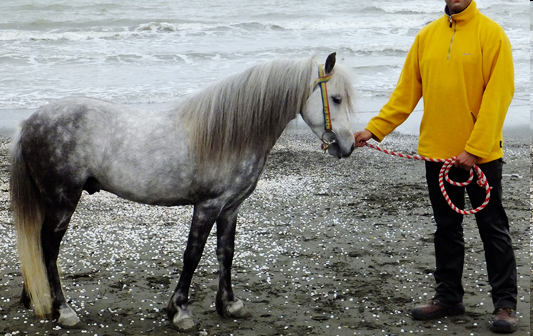
Baltic Sea native horse / Icelandic, Finnish, Estonian, Gotland and Nordland horses (Around 120-150 at the withers, descendant of Mongolian horses, used by viking traders in 700-900 AD and taken to Iceland. Later used by the Swedish cavalry in the 30 years war and by the Finnish army in the Second World War, nowadays harness racing and draught horses)

Siberian native horse / Yakutian pony (Around 120-140 at the withers, related to Baltic and Mongolian horses and at least as old, as well-adapted to Siberian climate as woolly mammoths once were, the hairiest horse there is, used in draught work and herding)

Mediterranean native horse / Skyros pony, Sardinian Giara, Monterufolino (Around 100-140 at the Withers, used and bred by ancient Greeks for cavalry use, influenced by African and Eastern breeds, further had its own influence on Celtic breeds via Roman Empire, still used by park ranger officers in Italy)
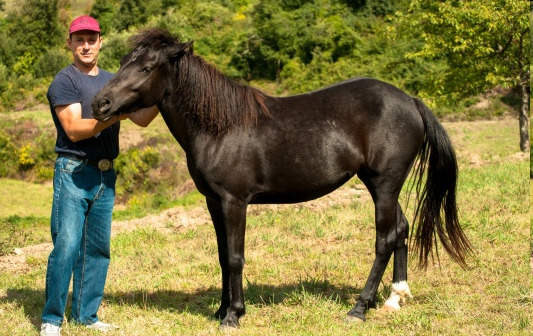
British Isles’ native horse / various “Mountain & Moorland” pony breeds (Around 100-150 at the withers, brought over and mixed by Celts, Romans and Vikings, base for almost every modern sport pony and the deserving main pony of all your British Medieval settings. Some populations still live as feral herds in the British countryside, used as war mounts, draught horses, mine pit ponies, hunting help and race horses)

So hey, now you know!
64K notes
·
View notes
Text
Caves are weirder and more varied than you think



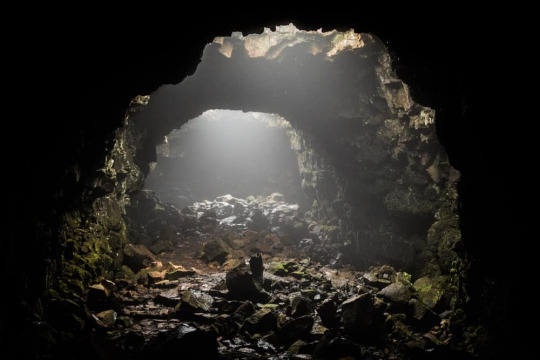

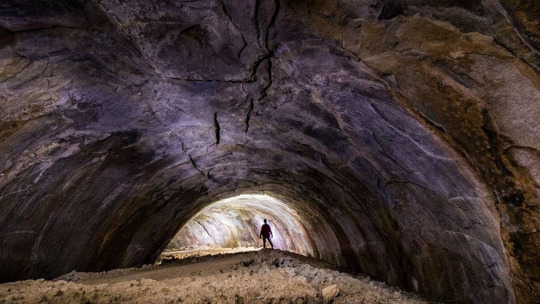
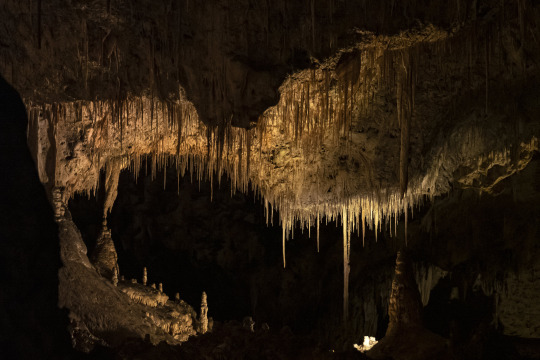


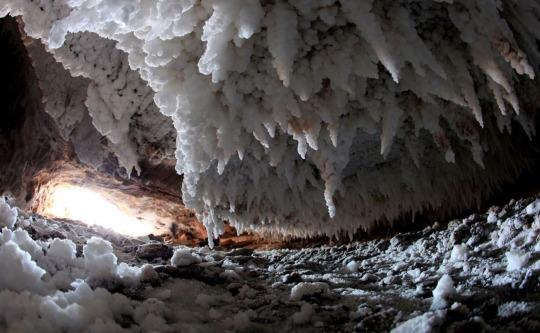
143K notes
·
View notes
Text
What's up folks, I updated the novel draft in my pinned post yesterday! Chapter 32 is where I remember that the Wild Hunt did some "Red Dead Redemption" style shit in an earlier part of the story, and since there's not many modern-day cavalry riders, my cast now has to find civilian riders and reenactors who are willing to attempt as-safe-as-possible simulations to help rescue his future victims.
Most of them fail miserably, what with not being cavalry riders who have been riding AND fighting since childhood!
Meanwhile, (fairies who look like) Littlefinger and Arthur Morgan are VERY displeased at being dragged out of retirement by a king who doesn't do much kingly stuff--like repairing the roads, or maybe asking someone a LITTLE YOUNGER than them to go murdering people in two days.
I swear I'll get to the part where the Tagalog gods duke it out with the Wild Hunt soon.
1 note
·
View note
Text
Love how tumblr has its own folk stories. Yeah the God of Arepo we’ve all heard the story and we all still cry about it. Yeah that one about the woman locked up for centuries finally getting free. That one about the witch who would marry anyone who could get her house key from her cat and it’s revealed she IS the cat after the narrator befriends the cat.
324K notes
·
View notes
Text
Man, I have the original link saved! Great to see it's updated! http://www.mrinitialman.com/OddsEnds/Sizes/sizes.html
hot artists don't gatekeep
I've been resource gathering for YEARS so now I am going to share my dragons hoard
Floorplanner. Design and furnish a house for you to use for having a consistent background in your comic or anything! Free, you need an account, easy to use, and you can save multiple houses.
Comparing Heights. Input the heights of characters to see what the different is between them. Great for keeping consistency. Free.
Magma. Draw online with friends in real time. Great for practice or hanging out. Free, paid plan available, account preferred.
Smithsonian Open Access. Loads of free images. Free.
SketchDaily. Lots of pose references, massive library, is set on a timer so you can practice quick figure drawing. Free.
SculptGL. A sculpting tool which I am yet to master, but you should be able to make whatever 3d object you like with it. free.
Pexels. Free stock images. And the search engine is actually pretty good at pulling up what you want.
Figurosity. Great pose references, diverse body types, lots of "how to draw" videos directly on the site, the models are 3d and you can rotate the angle, but you can't make custom poses or edit body proportions. Free, account option, paid plans available.
Line of Action. More drawing references, this one also has a focus on expressions, hands/feet, animals, landscapes. Free.
Animal Photo. You pose a 3d skull model and select an animal species, and they give you a bunch of photo references for that animal at that angle. Super handy. Free.
Height Weight Chart. You ever see an OC listed as having a certain weight but then they look Wildly different than the number suggests? Well here's a site to avoid that! It shows real people at different weights and heights to give you a better idea of what these abstract numbers all look like. Free to use.
181K notes
·
View notes
Text
Me: *wrote a car chase scene a while back where the Irish Wild Hunt's riders can 1) jump a horse over a speeding car, and 2) jump OFF a horse onto that speeding car; is now writing the latest chapter where everyone tries to get riders with the equivalent skills* Man, is that even possible if you and your horse aren't magical?
*searches the Internet, finds out that riders throughout history have done a lot of Red Dead Redemption stunts, as long as you are skilled AND turn off everyone's pesky self-preservation instincts*
Me: Well. Time to write about a lot of people failing to make their horse jump over a car... when it starts MOVING.
The novel draft in question is Moonflowers, by the way!

5 notes
·
View notes
Text
Reading a book about slavery in the middle-ages, and as the author sorts through different source materials from different eras, I am starting to understand why so many completely fantastical accounts of "faraway lands" went without as much as a shrug. The world is such a weird place that you can either refuse to believe any of it or just go "yeah that might as well happen" and carry on with your day.
There was this 10th century arab traveller who wrote into an account that the fine trade furs come from a land where the night only lasts one hour in the summer and the sun doesn't rise at all in the winter, people use dogs to travel, and where children have white hair. I don't think I'd believe something like that either if I didn't live here.
67K notes
·
View notes
Text
Your weekly reminder that this post has a LOT of hyperfixation building on the original post, lolol
Preindustrial travel, and long explanations on why different distances are like that
Update March 1, 2024: Hey there folks, here's yet another update! I reposted Part 2a (the "medieval warhorses" tangent) to my writing blog, and I went down MORE of the horse-knowledge rabbit hole! https://www.tumblr.com/jadevine/741423906984951808/my-post-got-cut-off-so-i-added-the-rest-of-it
Update Jan 30, 2024: Hey folks, I've posted the updated version of this post on my blog, so I don't have to keep frantically telling everyone "hey, that's the old version of this post!" https://thebalangay.wordpress.com/2024/01/29/preindustrial-travel-times-part-1/
I should get the posts about army travel times and camp followers reformatted and posted to my blog around the end of the week, so I'll filter through my extremely tangled thread for them.
Part 2 - Preindustrial ARMY travel times: https://www.tumblr.com/jadevine/739342239113871360/now-for-a-key-aspect-that-many-people-often-ask
Part 2a - How realistic warhorses look and act, because the myth of "all knights were mounted on huge clunky draft horses" just refuses to die: https://www.tumblr.com/jadevine/732043691180605440/helpful-things-for-action-writers-to-remember
Part 3 - Additional note about camp followers being regular workers AND sex-workers: https://www.tumblr.com/jadevine/740604203134828544/reblogging-the-time-looped-version-of-my
--
I saw a post on my main blog about how hiking groups need to keep pace with their slowest member, but many hikers mistakenly think that the point of hiking is "get from Point A to Point B as fast as possible" instead of "spending time outdoors in nature with friends," and then they complain that a new/less-experienced/sick/disabled hiker is spoiling their time-frame by constantly needing breaks, or huffing and puffing to catch up.
I run into a related question of "how long does it take to travel from Point A to Point B on horseback?" a lot, as a fantasy writer who wants to be SEMI-realistic; in the Western world at least, our post-industrial minds have largely forgotten what it's like to travel, both on our own feet and in groups.
People ask the new writer, "well, who in your cast is traveling? Is getting to Point B an emergency or not? What time of year is it?", and the newbies often get confused as to why they need so much information for "travel times." Maybe new writers see lists of "preindustrial travel times" like a primitive version of Google Maps, where all you need to do is plug in Point A and Point B.
But see, Google Maps DOES account for traveling delays, like different routes, constructions, accidents, and weather; you as the person will also need to figure in whether you're driving a car versus taking a bus/train, and so you'll need to figure out parking time or waiting time for the bus/train to actually GET THERE.
The difference between us and preindustrial travelers is that 1) we can outsource the calculations now, 2) we often travel for FUN instead of necessity.
The general rule of thumb for preindustrial times is that a healthy and prime-aged adult on foot, or a rider/horse pair of fit and prime-aged adults, can usually make 20-30 miles per day, in fair weather and on good terrain.
Why is this so specific? Because not everyone in preindustrial times was fit, not everyone was healthy, not everyone was between the ages of 20-35ish, and not everyone had nice clear skies and good terrain to travel on.
If you are too far below 18 years old or too far past 40, at best you will need either a slower pace or more frequent breaks to cover the same distance, and at worst you'll cut the travel distance in half to 10 or so miles. Too much walking is VERY BAD on too-young/old knees, and teenagers or very short adults may just have short legs even if they're fine with 8-10 hours of actual walking. Young children may get sick of walking and pitch a fit because THEY'RE TIREDDDDDDDDDD, and then you might need to stay put while they cry it out, or an adult may sigh and haul them over their shoulder (and therefore be weighed down by about 50lbs of Angry Child).
Heavy forests, wetlands and rocky hills/mountains are also going to be a much shorter "distance" per day. For forests or wetlands, you have to account for a lot of villagers going "who's gonna cut down acres of trees for one road? NOT ME," or "who's gonna drain acres of swamp for one road? NOT ME." Mountainous regions have their traveling time eaten by going UP, or finding a safer path that goes AROUND, so by the time you're done slogging through drier patches of wetlands or squeezing through trees, a deceptively short 10-15 miles in rough terrain might take you a whole day to walk instead of the usual half-day.
If you are traveling in freezing winters or during a rainstorm (and this inherently means you HAVE NO CHOICE, because nobody in preindustrial times would travel in bad weather if they could help it), you run the high risk of losing your way and then dying of exposure or slipping and breaking your neck, just a few miles out of the town/village.
Traveling in TOO-HOT weather is just as bad, because pushing yourself too hard and getting dehydrated at noon in the tropics will literally kill you. It's called heat-STROKE, not "heat-PARTY."
And now for the upper range of "traveling on horseback!"
Fully mounted groups can usually make 30-40 miles per day between Point A and Point B, but I find there are two unspoken requirements: "Point B must have enough food for all those people and horses," and "the mounted party DOESN'T need to keep pace with foot soldiers, camp followers, or supply wagons."
This means your mounted party would be traveling to 1) a rendezvous point like an ally's camp or a noble's castle, or 2) a town/city with plenty of inns. Maybe they're not literally going 30-40 miles in one trip, but they're scouting the area for 15-20 miles and then returning to their main group. Perhaps they'd be going to an allied village, but even a relatively small group of 10-20 warhorses will need 10-20 pounds of grain EACH and 20-30 pounds of hay EACH. 100-400 pounds of grain and 200-600 pounds of hay for the horses alone means that you need to stash supplies at the village beforehand, or the village needs to be a very large/prosperous one to have a guaranteed large surplus of food.
A dead sprint of 50-60 miles per day is possible for a preindustrial mounted pair, IF YOU REALLY, REALLY HAVE TO. Moreover, that is for ONE day. Many articles agree that 40 miles per day is already a hard ride, so 50-60 miles is REALLY pushing the envelope on horse and rider limits.
NOTE: While modern-day endurance rides routinely go for 50-100 miles in one day, remember that a preindustrial rider will not have the medical/logistical support that a modern endurance rider and their horse does.
If you say "they went fifty miles in a day" in most preindustrial times, the horse and rider's bodies will get wrecked. Either the person, their horse, or both, risk dying of exhaustion or getting disabled from the strain.
Whether you and your horse are fit enough to handle it and "only" have several days of defenselessness from severe pain/fatigue (and thus rely on family/friends to help you out), or you die as a heroic sacrifice, or you aren't QUITE fit enough and become disabled, or you get flat-out saved by magic or another rider who volunteers to go the other half, going past 40 miles in a day is a "Gondor Calls For Aid" level of emergency.
As a writer, I feel this kind of feat should be placed VERY carefully in a story: Either at the beginning to kick the plot off, at the climax to turn the tide, or at the end.
Preindustrial people were people--some treated their horses as tools/vehicles, and didn't care if they were killed or disabled by pushing them to their limits, but others very much cared for their horses. They needed to keep them in working condition for about 15-20 years, and they would not dream of doing this without a VERY good reason.
—
UPDATE January 13: Several people have gotten curious and looked at maps, to find out how a lot of cities are indeed spread out at a nice distance of 20-30 miles apart! I love getting people interested in my hyperfixations, lol.
But remember that this is the space between CITIES AND TOWNS. There should never be a 20-mile stretch of empty wilderness between City A and Town B, unless your world explains why folks are able to build a city in the middle of nowhere, or if something has specifically gone wrong to wipe out its supporting villages!
Period pieces often portray a shining city rising from a sea of picturesque empty land, without a single grain field or cow pasture in sight, but that city would starve to death very quickly in preindustrial times.
Why? Because as Bret Devereaux mentions in his “Lonely Cities” article (https://acoup.blog/2019/07/12/collections-the-lonely-city-part-i-the-ideal-city/), preindustrial cities and towns must have nearby villages (and even smaller towns, if large and prosperous enough!) to grow their food for them.
The settlements around a city will usually be scattered a few miles apart from each other, usually clustered along the roads to the city gates. Those villages and towns at the halfway point between cities (say 10-15 miles) are going to be essential stops for older/sick folks, merchants with cargo, and large groups like noble’s retinues and army forces.
Preindustrial armies and large noble retinues usually can’t make it far past 10-12 miles per day, as denoted in my addition to this post. (https://www.tumblr.com/jadevine/739342239113871360/now-for-a-key-aspect-that-many-people-often-ask )
7K notes
·
View notes
Text
Folds in quite nicely with my "preindustrial travel times" segment, where I also cite Bret's article series of "The Lonely City!"
https://jadevine.tumblr.com/post/738801850678116352/preindustrial-travel-and-long-explanations-on-why
hi I'm from your pseudo-medieval fantasy city. yeah. you forgot to put farms around us. we have very impressive walls and stuff but everyone here is starving. the hero showed up here as part of his quest and we killed and ate him
30K notes
·
View notes
Text
reminder to worldbuilders: don't get caught up in things that aren't important to the story you're writing, like plot and characters! instead, try to focus on what readers actually care about: detailed plate tectonics
119K notes
·
View notes
Text

This is.....niche. Do period-appropriate chickens even still exist? Idk anything about chickens. I like the fancy ones.
71K notes
·
View notes
Text
Forgot to tell folks that my laptop was fixed on March 12! I've been posting a lot on my two other blogs, but it's kind of hard to update about my writing when the whole point of that is... writing and trying to finish a chapter.
The repair guy fixed my laptop in half an hour because he had to wipe my Windows operating system, so he didn't let me pay for it.
I suspect Tony Stark was behind this, given that I was panicking on Facebook and went "Tony Stark, please make sure I don’t need to get a new laptop JUST yet."
I make a lot of sarcastic pop-culture "prayers" on Facebook, but if you want more of that actual pop-culture paganism mess, check out my spirituality and FORMER writing blog at @norcalbruja .
Laptop issues are happening, so my future posts may be delayed by real-life. There is No Damn Way I’m trying to copy and paste full length posts on my phone, ughhhhh.
2 notes
·
View notes
Text
Checking if my followers see my posts
While I greatly appreciate stumbling across the logistics nerds and the horse-girls of Tumblr, I would really appreciate if more of those 5000-ish people threw a bit more energy towards the actual works I talk about in my pinned post
4 notes
·
View notes
Text
What's up, my followers! As a Filipino-American whose culture is often reduced to being nice, being Catholic, or having good party food, I feel a very deep kinship with ANOTHER island country who got colonized by Christianity.
youtube
I was at work today and I heard basically no Irish music in eight hours, so some places aren't even paying lip-service to Irish people/culture. I find this a timely reminder of "a culture that is technically white, but marginalized in Europe as one of the 'bottom rungs' of whiteness, and their culture is constantly gutted and used as window-dressing by outsiders who have no idea what they're about, besides shamrocks and the Fair Folk and whiskey."
So here's The Cranberries' Zombie, often used for Halloween by people who haven't actually listened to the lyrics, or heard what the band actually said about it.
10 notes
·
View notes
Text
Inching closer to the modern-day side of my Marvel fanfic's plot
So being a person who wears glasses all the time and has to deal with regular people's often-weird ideas about "not being able to see well," I've got three low-vision/glasses-wearing characters in my Marvel fanfic "The Lightning-Axe," and their powers will never really compensate for their physical eyesight.
Ulupong: Has glasses. A pagan Filipino merfolk prince who also shapeshifts into a cobra (hence his very appropriate name). Besides being a merman who can live and breathe underwater, his only INDIVIDUAL powers are "shapeshifting into a spitting cobra, with the subsequent abilities of 'being the second-most notorious snake in the Philippines'" and "being immune to a LOT of, if not all, poisons." Tends to be a melee fighter because THE BRO CANNOT SEE PAST TEN FEET, do you expect him to be an archer??? It also seems that cobras don't have heat/infrared vision, so this worked out especially great for me!
Sootz': Normal Mayan guy, was born premature and now needs glasses. His powers are "being nice to bats and trying to remove the stigma around them," which helps a LOT in the Otherworld when they end up fighting the Filipino sun-spirit called Araw and Camazotz the bat-god has to end the daytime so their ship can get the fuck away from him.
Araw: The one-eyed primordial Sun of the Tagalogs, implied to be a God-Tier mutant like Kukulkan / Namor. He has fuck-all to do with the Filipino flag as a colonial invention, and he would burn it to ash if he saw one. He lost one eye in a duel with Bathala, and in the story, ancient Tagalogs used to view the mortal world's sun as his other eye and he can't go back to the mortal world proper, or else he'll return to full strength and burn the world just by existing. His powers: Turning into a giant flaming eagle, being immune to most cold temperatures, being immune to most hot temperatures, healing most burn-wounds (but only those caused by FIRE, so ice burns and magical "burns" like the Infinity Gauntlet are out of his jurisdiction) metaphorically "seeing" the multiverse and knowing how a lot of things turned or will-turn out, and not giving a fuck what anyone says about him.
WHO can beat the Tagalog Sun, though? Usually proper deities and very powerful superheroes. The key thing is that he loses his fire-powers at night, so then he "just" becomes a hot immortal Pinoy seer. If you want to beat Araw with water, you need to basically flood the place, or trap him underwater at sunset with some gangster-style cement shoes. (Obviously, he won't drown--but it's gonna take him the night to regain his fire-powers, and by then you've had at least several hours to Run The Fuck Away From Him! He'll still have to LOOK FOR YOU!)
Once the group manages to beat him and he feels extreme remorse over attempting to kidnap Ulupong's girlfriend Lawin and trying to burn off Ulupong's leg, they find out the Sun is a very good ally and he happens to have a history with the Norse gods (in that he got banned from Asgard when Loki and Thor were about three years old).
Unfortunately I made a stupid decision by deciding to worldbuild Talokan's origins, so I've still got about five hundred years of colonization to slog through before we actually MEET these guys!
If anyone wants to check this out alongside my logistics-nerd and grown-up-horse-girl ramblings, please do!
3 notes
·
View notes
Text
Laptop issues are happening, so my future posts may be delayed by real-life. There is No Damn Way I’m trying to copy and paste full length posts on my phone, ughhhhh.
2 notes
·
View notes
Text
A nice chunk of Mongolia uses Cyrillic in everyday life, so using Cyrillic doesn't GUARANTEE that something is "Russian."
Anyway, back to logistics. It's really interesting to see how the Russian coachmen started out as peasants/commoners, jumped up to a middle/upper-class caste once the postal service proper was established, and then they got knocked back down to commoner status by a proper railway system in the 1850s.
The Russian coachmen being supplanted by better technology is a striking parallel to the Japanese samurai.
Most were not much better than foot-soldiers, but the higher ranks of samurai were aristocrats either holding land in their own right, or serving as retainers to wealthier lords who paid them in rice, and the samurai would resell it for whatever else they needed.
Many Japanese nobles became impoverished in the 1600s as the merchant class rose to power, so the price of rice plummeted. In simplistic terms, the samurai were forced to either 1) give up their SWORD and work their estate alongside the peasants they technically "rule," or 2) give up their LAND and move to their lord's estate as a full-time retainer.
So you suddenly have 5-7% of the country's men who must either give up their home to keep the life they're accustomed to, or give up the scraps of nobility they have and GET A JOB. The horror. (Sarcasm, just in case.)
Granted, there were MANY types of samurai (some sources say a hundred!) and most of them were basically regular soldiers, but even if half or two-thirds of the samurai were “not really nobility” and they were fine with either moving a step down to actual working class, or moving to their lord's domain as permanent retainers?
This still leaves a VERY high 2-4% of the population being armed AND privileged men, who are mad about the changes in society and really want things to go back to how they were, before those damn merchants flooded the rice market. 2-4% of a population is effectively the size of a preindustrial farming region's ARMY, and when that army finds out about the succession crisis in the capital and effectively leaves the country leaderless? That’s when the local lords (called daimyo) rallied their vassals to carve out their own provinces, and SO the Sengoku Jidai / Japanese "Warring States" period happened.
Too much food: Can sow the seeds (lol) that plunge a country into a civil war!
I went off on a tangent about how the samurai being 5-7% of a given region’s men is considered notoriously high among historians, and why arming so many people is a Very Bad Idea for a lot of preindustrial cultures... and then I went into ANOTHER tangent about how the idea of "nobles are sheltered aristocrats who leech off the peasantry" tends to war against the idea of "nobles were warriors! They were supposed to fight and they could totally rough it in the wilderness if needed!", but those two ideas can and did coexist at the same time.
Both those concepts are going to be in another post.
Preindustrial travel, and long explanations on why different distances are like that
I saw a post on my main blog about how hiking groups need to keep pace with their slowest member, but many hikers mistakenly think that the point of hiking is "get from Point A to Point B as fast as possible" instead of "spending time outdoors in nature with friends," and then they complain that a new/less-experienced/sick/disabled hiker is spoiling their time-frame by constantly needing breaks, or huffing and puffing to catch up.
I run into a related question of "how long does it take to travel from Point A to Point B on horseback?" a lot, as a fantasy writer who wants to be SEMI-realistic; in the Western world at least, our post-industrial minds have largely forgotten what it's like to travel, both on our own feet and in groups.
People ask the new writer, "well, who in your cast is traveling? Is getting to Point B an emergency or not? What time of year is it?", and the newbies often get confused as to why they need so much information for "travel times." Maybe new writers see lists of "preindustrial travel times" like a primitive version of Google Maps, where all you need to do is plug in Point A and Point B.
But see, Google Maps DOES account for traveling delays, like different routes, constructions, accidents, and weather; you as the person will also need to figure in whether you're driving a car versus taking a bus/train, and so you'll need to figure out parking time or waiting time for the bus/train to actually GET THERE.
The difference between us and preindustrial travelers is that 1) we can outsource the calculations now, 2) we often travel for FUN instead of necessity.
The general rule of thumb for preindustrial times is that a healthy and prime-aged adult on foot, or a rider/horse pair of fit and prime-aged adults, can usually make 20-30 miles per day, in fair weather and on good terrain.
Why is this so specific? Because not everyone in preindustrial times was fit, not everyone was healthy, not everyone was between the ages of 20-35ish, and not everyone had nice clear skies and good terrain to travel on.
If you are too far below 18 years old or too far past 40, at best you will need either a slower pace or more frequent breaks to cover the same distance, and at worst you'll cut the travel distance in half to 10 or so miles. Too much walking is VERY BAD on too-young/old knees, and teenagers or very short adults may just have short legs even if they're fine with 8-10 hours of actual walking. Young children may get sick of walking and pitch a fit because THEY'RE TIREDDDDDDDDDD, and then you might need to stay put while they cry it out, or an adult may sigh and haul them over their shoulder (and therefore be weighed down by about 50lbs of Angry Child).
Heavy forests, wetlands and rocky hills/mountains are also going to be a much shorter "distance." For forests or wetlands, you have to account for a lot of villagers going "who's gonna cut down acres of trees for one road? NOT ME," or "who's gonna drain acres of swamp for one road? NOT ME." Mountainous regions have their traveling time eaten by going UP, or finding a safer path that goes AROUND.
If you are traveling in winter or during a rainstorm (and this inherently means you HAVE NO CHOICE, because nobody in preindustrial times would travel in bad weather if they could help it), you run the high risk of losing your way and then dying of exposure or slipping and breaking your neck, just a few miles out of the town/village.
And now for the upper range of "traveling on horseback!"
Fully mounted groups can usually make 30-40 miles per day between Point A and Point B, but I find there are two unspoken requirements: "Point B must have enough food for all those people and horses," and "the mounted party DOESN'T need to keep pace with foot soldiers, camp followers, or supply wagons."
This means your mounted party would be traveling to 1) a rendezvous point like an ally's camp or a noble's castle, or 2) a town/city with plenty of inns. Maybe they're not literally going 30-40 miles in one trip, but they're scouting the area for 15-20 miles and then returning to their main group. Perhaps they'd be going to an allied village, but even a relatively small group of 10-20 warhorses will need 10-20 pounds of grain EACH and 20-30 pounds of hay EACH. 100-400 pounds of grain and 200-600 pounds of hay for the horses alone means that you need to stash supplies at the village beforehand, or the village needs to be a very large/prosperous one to have a guaranteed large surplus of food.
A dead sprint of 50-60 miles per day is possible for a preindustrial mounted pair, IF YOU REALLY, REALLY HAVE TO. Moreover, that is for ONE day. Many articles agree that 40 miles per day is already a hard ride, so 50-60 miles is REALLY pushing the envelope on horse and rider limits.
NOTE: While modern-day endurance rides routinely go for 50-100 miles in one day, remember that a preindustrial rider will not have the medical/logistical support that a modern endurance rider and their horse does.
If you say "they went fifty miles in a day" in most preindustrial times, the horse and rider's bodies will get wrecked. Either the person, their horse, or both, risk dying of exhaustion or getting disabled from the strain.
Whether you and your horse are fit enough to handle it and "only" have several days of defenselessness from severe pain/fatigue (and thus rely on family/friends to help you out), or you die as a heroic sacrifice, or you aren't QUITE fit enough and become disabled, or you get flat-out saved by magic or another rider who volunteers to go the other half, going past 40 miles in a day is a "Gondor Calls For Aid" level of emergency.
As a writer, I feel this kind of feat should be placed VERY carefully in a story: Either at the beginning to kick the plot off, at the climax to turn the tide, or at the end.
Preindustrial people were people--some treated their horses as tools/vehicles, and didn't care if they were killed or disabled by pushing them to their limits, but others very much cared for their horses. They needed to keep them in working condition for about 15-20 years, and they would not dream of doing this without a VERY good reason.
7K notes
·
View notes